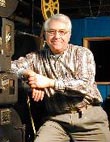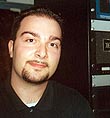|
|
This topic comprises 2 pages: 1 2
|
|
Author
|
Topic: Vu-Meter
|
|
|
|
|
|
|
|
|
|
|
|
|
|
|
|
|
John Anastasio
Master Film Handler

Posts: 325
From: Trenton, NJ, USA
Registered: Sep 2000
|
 posted 05-23-2002 08:31 PM
posted 05-23-2002 08:31 PM





Get the best volt/ohmmeter your budget will allow, but it really doesn't have to be very expensive to do this measurement. Since it looks like you want to actually see a meter (D'Arsonval movement), don't get a digital multimeter. Almost any voltmeter will have ranges that work up to around 1,000v and you're not going to see that kind of EMF at a speaker. Simpsons are great, but they're expensive. I have a $60 Radio Shack analog meter that I lug around. It works just fine, it's accurate enough and if I drop it, I won't shed any tears. (It's funny, though...how I only seem to drop the expensive stuff, never the junk). My favorite one used to be an old RCA Voltohmyst Vacuum Tube Voltmeter that I used for about 25 years until I finally entered the solid state age.
| IP: Logged
|
|
Frank Angel
Film God

Posts: 5305
From: Brooklyn NY USA
Registered: Dec 1999
|
 posted 05-24-2002 12:40 AM
posted 05-24-2002 12:40 AM





Antonio, i am assuming that what you are not trying to use this meter to get precision readings of the amp output, but you just want an indication of the relative power it is pumping out at any given moment and how close the amp is to its clipping point, am I right? The voltmeter setup is fine for this. You just want to calibrate it using a sinewave gen and oscope to determine the clipping point running into your normal speaker load. Set your meter to read in a range so it is not pinning when your amp just begins clipping. Then mark the point on your meter glass just below where clipping begins and you've got yourself a power meter that will give you the information that is most useful -- how close is your amp running to clipping at any given time. When calibrating, be sure to run your sine wave gen thru a range of frequencies rather than just say 1kHz as the amp may very well clip sooner at lower frequencies into real-life speaker loads.Lafayette Radio, a long-gone supply of cheap electrical parts and gear, made a power meter that basically was nothing more than the voltmeter setup with a simple buffer circuit that gave the needle smoothed-out ballistics. It had a convenient calibration pot that you set to the amp's clipping level. Since this was a consumer unit, their instructions as how to calibrate it was simply to turn up your amp until you could hear distortion and that was where you set your meter to read 0db -- it had markings above "0db" to +6db in red -- naturally the markings mean nothing. I still use them on my left & right surround amps just to see what they are doing. It's not a calibration-accurate meter, but it does tell me that I've got signal and that it is playing at normal levels. I think Radio Shack used to make a similar unit with nice big lighted meters and it even had peak indication LEDs to boot. Since I dread even walking into Radio Shack, I have no idea if they still make that unit, but it probably will accomplish what you are looking for.
| IP: Logged
|
|
|
|
Ray Derrick
Master Film Handler

Posts: 310
From: Sydney, Australia
Registered: Sep 2001
|
 posted 05-30-2002 06:19 AM
posted 05-30-2002 06:19 AM




Frank, I would be very wary about running a sine wave through a speaker system at levels high enough to produce amplifier clipping, at least not for more than a few seconds, particlarly considering that cinema amps typically have power ratings of at least 400 watts!Also it would be necessary to set your "meter" clipping reference point to around 6-8dB below the sine wave clipping point because the meter cannot react fast enought to real-world audio and so will give a false reading. The clip LEDs in amplifiers usually begin to glow at 10 to 8dB below clipping for this reason. ------------------
Ray Derrick
President/Chief Engineer
Panalogic Corporation Sydney, Australia
Phone: 61 (0)2 9894 6655 Fax: 61 (0)2 9894 6935
| IP: Logged
|
|
|
|
|
|
|
|
|
|
All times are Central (GMT -6:00)
|
This topic comprises 2 pages: 1 2
|
Powered by Infopop Corporation
UBB.classicTM
6.3.1.2
The Film-Tech Forums are designed for various members related to the cinema industry to express their opinions, viewpoints and testimonials on various products, services and events based upon speculation, personal knowledge and factual information through use, therefore all views represented here allow no liability upon the publishers of this web site and the owners of said views assume no liability for any ill will resulting from these postings. The posts made here are for educational as well as entertainment purposes and as such anyone viewing this portion of the website must accept these views as statements of the author of that opinion
and agrees to release the authors from any and all liability.
|

 Home
Home
 Products
Products
 Store
Store
 Forum
Forum
 Warehouse
Warehouse
 Contact Us
Contact Us




 Printer-friendly view of this topic
Printer-friendly view of this topic














